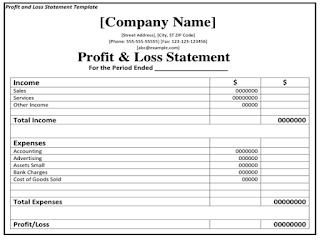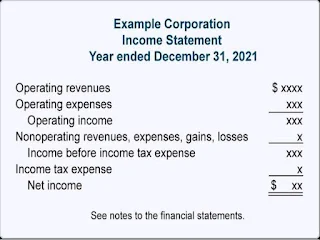Income Statement vs. Profit and Loss: Difference Between P&L and Income Statement
 |
| Difference Between P&L and Income Statement |
The Profit & Loss Statement (P&L) and the Income Statement are two expressions representing the same financial statement. The difference between the two terms lies in the context in which they are used.
Although some financial experts use the two terms interchangeably, what's the difference between a P&L and an income statement? We will cover everything you need to know in this article, but first, let's define profit & loss and income statement.
Definition of P&L and Income Statement
Here are the definitions of the two terms.
Meaning of P&L Statement
The P&L, or Profit and Loss statement, is a part of the financial statement that presents a summary of a company's revenues, expenditures, and costs incurred during a specific period, usually quarterly or annually. It shows whether a company has made a profit or incurred a loss over that period by subtracting total expenses from total revenue.
Meaning of Income Statement
An income statement is a financial report that shows a company's revenues, expenses, and profits over a specific period of time, typically quarterly or annually. It provides insight into a company's profitability by detailing its sources of revenue and the costs associated with generating that revenue.
Excerpts from the Definitions
From the definition of the terms above, we understand that the P&L (Profit and Loss) statement is for internal management use and isn't something the law forces companies to make, but it's important for them to do it anyway. Why? Because it's the best way to see how well a company is performing.
The Income Statement is like a detailed version of the P&L. It's made from the P&L and shows the actual income, expenses, and whether the company made a profit or loss over a specific time. Unlike the profit and loss statement, which is not required by law, the income statement is a must-have for financial reporting and is usually included with a company's other financial statements.
The P&L report looks at a certain time frame and tells you about the planned revenue, forecasted expenses, and expected net profit for a specific period. It also looks back to see how past changes affected your finances.
The income statement is a lot like the P&L, but it's based on real numbers. So, if your P&L says you'll earn £100, it won't appear as actual income on the income statement until you've actually sent out an invoice for that amount.
Income Statement vs. Profit and Loss: Purpose and Scope
An income statement considers mainly those expenses that were used up by the business while trying to generate revenue. These expenses include raw materials used in production or the cost of renting a retail shop where the company will sell its products.
On the other hand, there are expenses that are investments in the company's future. These aren't expected to be used up quickly within the period. These can include buying shares in other companies or investing in research and development programs that are for the future rather than immediate expenses.
The profit from the first set of expenses has to be used to pay for the costs from the second set, with the aim of getting back more than what was spent. Hence, the expenses from the first group will appear on the income statement.
The profit & loss statement shows both the money coming in (revenue) and going out (expenses). It also includes any changes in equity from sources other than the owners. However, sometimes people mistakenly use it to measure performance based on cash changes, assuming that revenue and expenses are all cash-based transactions.
5 Key Differences Between P&L and Income Statement
Here are the key differences between P&L and income statement:
- Terminology: In the business world, you'll often hear people refer to the "Profit and Loss" statement (P&L), while in academic and accounting circles, they tend to use the term "income statement" more often.
- Scope of usage: The "income statement" covers different types of income, like what a company earns from its operations and other sources. But "Profit and Loss" (P&L) is more about focusing on how profitable a company is by looking at its revenues and expenses over time.
- Internal vs. External Usage: P&L might be more commonly used internally within a company for management purposes, while income statements are often prepared for external stakeholders like investors, creditors, and regulatory authorities.
- Presentation Format: While the content is essentially the same, the presentation format might differ slightly between the two. P&L might be more tailored to internal reporting needs, whereas income statements follow specific accounting standards for external reporting purposes.
Key Components of P&L and Income Statement
The key components of both the profit and loss (P&L) statement and the income statement typically include the following:
- Revenue/Sales: The total income generated from selling goods or services.
- Cost of Goods Sold (COGS): The COGS (cost of goods sold) is the direct cost associated with producing the goods or services sold, including materials, labor, and manufacturing overhead.
- Gross Profit: The gross profit is calculated as revenue minus the cost of goods sold, representing the profit before deducting operating expenses.
- Operating Expenses: These expenses include selling, general, and administrative expenses (SG&A), such as marketing, salaries, rent, utilities, and other overhead costs.
- Operating Income: Gross profit minus operating expenses, indicating the profit earned from the company's core operations.
- Non-Operating Income/Expenses: Additional income or expenses not directly related to the core business operations, such as interest income, interest expenses, and gains or losses from investments.
- Net Income: The final profit or loss figure after subtracting all expenses, including operating and non-operating expenses, from total revenue.
Format and Presentation of P&L and Income Statement
The format and presentation of the profit and loss (P&L) statement and the income statement are quite similar, typically following these standard sections:
Format of a Profit and Loss Statement
A Profit and Loss Statement typically looks like this:
 |
| Format of a Profit and Loss Statement |
Format of an Income Statement
A Profit and Loss Statement typically looks like this:
 |
| Format of an Income Statement |
Conclusion: Difference Between P&L and Income Statement
People often use the terms "P&L" (profit and loss) and "income statement" interchangeably because they both represent the same financial statement, showing a company's profits and losses over a period of time.
While they're both financial statements, P&L and income statements differ in how they're prepared, when they're prepared, and who presents them.
P&L is a report that shows how profitable a company is on a specific date. It's prepared using the accrual method, and managers make it whenever they need it to make decisions.
On the other hand, the income statement is an accumulation report prepared using the cash method to show the company's profitability over a certain period. The income statement is automatically prepared after the company ends its accounting period.










